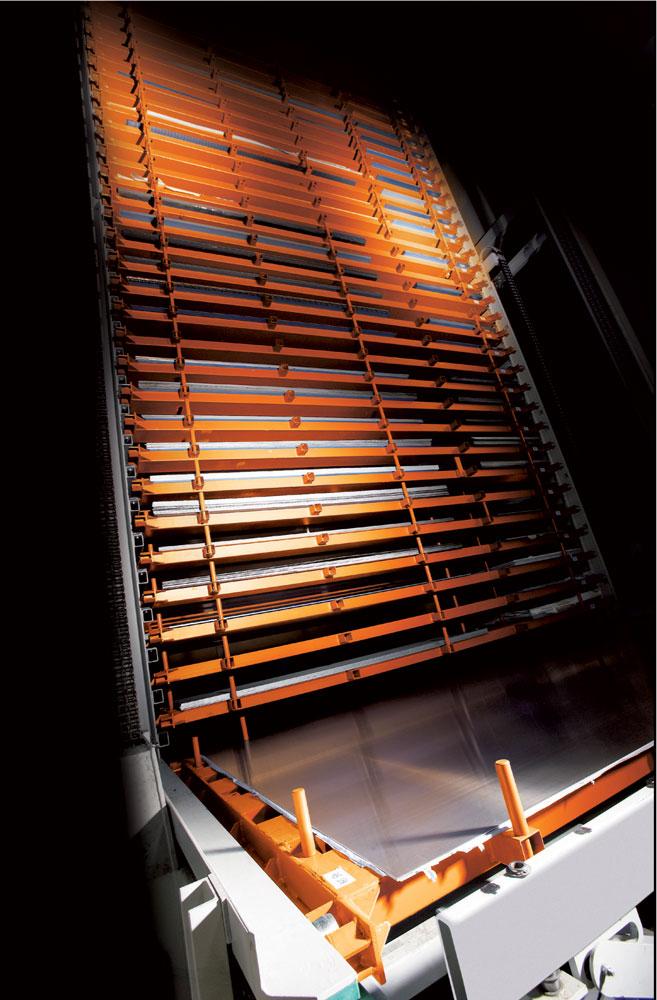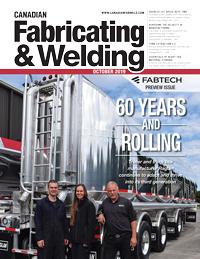Associate Editor
- FMA
- The Fabricator
- FABTECH
- Canadian Metalworking
Essentials of heavy fab material storage
A look at how fabricators can properly store and handle heavy material stock
- By Lindsay Luminoso
- October 22, 2019
- Article
- Fabricating

Adding a point-of-use storage system, like the KASTOecostore or KASTOunitower, is a great way to deal with material storage and handling challenges.
With shop floor space at a premium, storing stock material can be a challenge, especially if that material is heavy plate, tube, or pipe. Stefan Dolipski, vice-president, Kasto Inc., Schaumburg, Ill., explains how a storage system can benefit any shop and walks through the various models, features, and steps to successful implementation.
Canadian Fabricating & Welding: What are common challenges fabricators face when moving and storing heavy plates?
Stefan Dolipski: A lot of material configurations can be relatively heavy, making them hard to move. Additionally, with large plate, fabricators need to have shop floor space to move it around. It’s not like standard-size material that you can easily manipulate across the shop floor. And with that, where do you store it? For one thing, it can’t really be stacked high. The challenge with stacking is that if a fabricator needs material that is all the way at the bottom of the stack, then everything must be removed from the stack, which can be a challenge in itself, being both time-consuming and dangerous if not handled correctly.
A lot of logistics needs to go into moving the material correctly and safely to avoid injury. There are a lot of situations where workers can hurt themselves because they have to move material back and forth or a plate that is picked up with a magnet and dropped back down. There is a lot of movement with heavy-duty, heavyweight components, which is a challenge for everyone.
Just the sheer length and size of the material coming in and going out of the shop can be a problem for fabricators. So shops are looking for an easier way to store and handle heavy fab materials. We are also seeing customers looking for more automated systems to remove the labour-intensiveness away from workers and put the onus on the machines. This is becoming more and more prevalent as labour shortages continue.
One of the big challenges we see on the heavy plate side is that there is an inclination to put a big plate upright on its end to save floor space. This can be a huge safety hazard. If the material falls, it could cause serious damage to both surrounding equipment and workers. This is why laying material flat in a storage and retrieval system is the best option and makes material handling easier.
CFW: What can fabricators expect from a storage or material handling system?
Dolipski: At the beginning, many fabricators have serious sticker shock. However, the value of adding a storage or material handling system is huge. These systems can be an asset for any fabricator, but especially those working with heavy or large materials. Once we explain what exactly these systems can do for a shop, that sticker shock goes away.
One of the first savings fabricators will see is in floor space. Nowadays floor space is getting a lot more expensive, and having the ability to maximize that space with equipment to serve customers is the key. In situations where space is not a problem, shops still need to be strategic with their material storage and handling. They can’t just store material all over the place. Adding a point-of-use storage system near respective machines is a great way to deal with this challenge.
Another area of savings comes with material handling. Many shops use forklifts or cranes to help with material storage and handling. These machines require skilled operators and manpower to help keep the shop moving. However, many automated options are available to help alleviate this challenge. Once a shop has implemented an automated storage system, the machine does most of the work. What this means is that it no longer requires a person standing ready with a forklift. That worker is freed up to work in other areas of the shop.

Laying material flat in a storage and retrieval system, like the KASTOunitower or KASTOuniline, is the safest option and makes material handling easier.
On this same note, much of the material that is being handled in heavy fabrication, beyond being large and bulky, tends to be expensive. Manual storage and handling can lead to damage, especially if the operator is inexperienced or rushed. We see a lot of damage when it comes to loading and handling material by forklifts.
So if the material is stored in the trays of an automated storage system, it has a fixed location that is protected from the everyday movement on the shop floor, meaning less scrap material due to damage. And it can be sorted based on need to allow more efficient handling.
CFW: With all the options currently available, how do shops choose the right storage system?
Dolipski: One of the first things that we usually like to look at is how much storage is needed. We need to know the storage requirements and how they are spread across the shop floor. We also need to know what the heavy setup looks like; what the shop’s general material handling habits are; and what the biggest material size expected is. We start off with some basic questions that will help determine which system is right for a shop’s particular needs.
Based on that basic customer feedback, we can then go into more specifics like how many picks will be needed and whether the shop wants a number of smaller storage systems near machines for specific jobs or a larger warehousing-type system for large-quantity storage of material that will be used in multiple different positions throughout the shop.
It’s really about seeing how the shop is currently set up and configured and finding where they can gain efficiencies by integrating a storage system. Integrating a small system has lower upfront costs and is great for smaller shops that don’t have the capacity for one of the larger systems. These options tend to be stand-alone and don’t always have the option for significant reconfiguration. The larger systems offer more modularity and can be expanded both in size and capabilities as a shop sees fit.
CFW: Beyond the standard systems, what features or specifications can shops include?
Dolipski: One of the big pushes right now is for inventory management. Some more manual machines are available on the market that don’t always have the ability for inventory control. This can be a challenge for shops because they are then required to manually maintain inventory counts. With a more intuitive system, a shop actually has the ability to track inventory across all machines and utilize all remnants available, saving money in the process. Incorporating an intuitive storage system will help cut down human error and maximize utilization of all material coming in and going out of the shop.
Beyond inventory management, automation can also play a big role, especially on the heavy fab side of things. Devices can be integrated into a storage system that help the operator move the materials in and out of compartments. This limits the amount of material handling-related injuries.
Depending on need, shops can integrate something like an automatic manipulator that will grab material and place it on the laser table, then feed it in. The laser will cut, and when the material comes out, the manipulator will then put it on a remnant skid and move it back into the storage system for later processing. This can go hand-in-hand with an inventory management system or be used on its own.

With larger warehouse systems, like the KASTOuniline and KASTO unicompact, more is involved on the implementation side. With these types of systems, fabricators will see significant productivity gains, but there are some upfront investments and requirements that need to be in place.
There are so many different options available to fabricators depending on the shop needs. From the small, basic models up to sophisticated warehousing options, finding the right configuration is easy.
CFW: What is involved in the implementation of a storage system?
Dolipski: For the smaller point-of-use systems, newer shops have a foundation underneath that is heavy enough, so nothing really needs to be done. Most system requirements have relatively low power consumption. So a shop generally isn’t required to make a significant investment on that side either. For the most part, not a lot of investment is needed to implement a system, except for deciding on where to place it on the shop floor. One of the most economical spots is placing a smaller storage system right next to the table or equipment the material will be needed for.
With larger warehouse systems, more is involved on the implementation side, specifically with the foundation and power source requirements. With these types of systems, fabricators will see significant productivity gains, but there are some upfront investments and requirements that need to be in place. A lot of times fabricators have limited floor space, and these systems can use vertical shop space right up to the ceiling height. However, shops can also look at the possibility of installing the storage machine outside of the building in its own housing frame and have it feed into the shop. This way, a shop is not losing any floor space. Installing a machine on the outside of the building, depending on the region, could also lead to tax benefits. So it’s definitely something to think about.
One important thing to remember is that when fabricators implement a storage system, having local support can be beneficial. Finding a supplier that can install and service the machine when needed can make or break the success of a material handling system.
Associate Editor Lindsay Luminoso can be reached at lluminoso@canadianfabweld.com.
Kasto, www.kasto.ca
About the Author

Lindsay Luminoso
1154 Warden Avenue
Toronto, M1R 0A1 Canada
Lindsay Luminoso, associate editor, contributes to both Canadian Metalworking and Canadian Fabricating & Welding. She worked as an associate editor/web editor, at Canadian Metalworking from 2014-2016 and was most recently an associate editor at Design Engineering.
Luminoso has a bachelor of arts from Carleton University, a bachelor of education from Ottawa University, and a graduate certificate in book, magazine, and digital publishing from Centennial College.
Related Companies
subscribe now


Keep up to date with the latest news, events, and technology for all things metal from our pair of monthly magazines written specifically for Canadian manufacturers!
Start Your Free Subscription- Industry Events
MME Saskatoon
- May 28, 2024
- Saskatoon, SK Canada
CME's Health & Safety Symposium for Manufacturers
- May 29, 2024
- Mississauga, ON Canada
DiPaolo Machine Tools Open House 2024
- June 4 - 5, 2024
- Mississauga, ON Canada
FABTECH Canada
- June 11 - 13, 2024
- Toronto, ON Canada
Zoller Open House & Technology Days 2024
- June 12 - 13, 2024
- Ann Arbor, MI




















